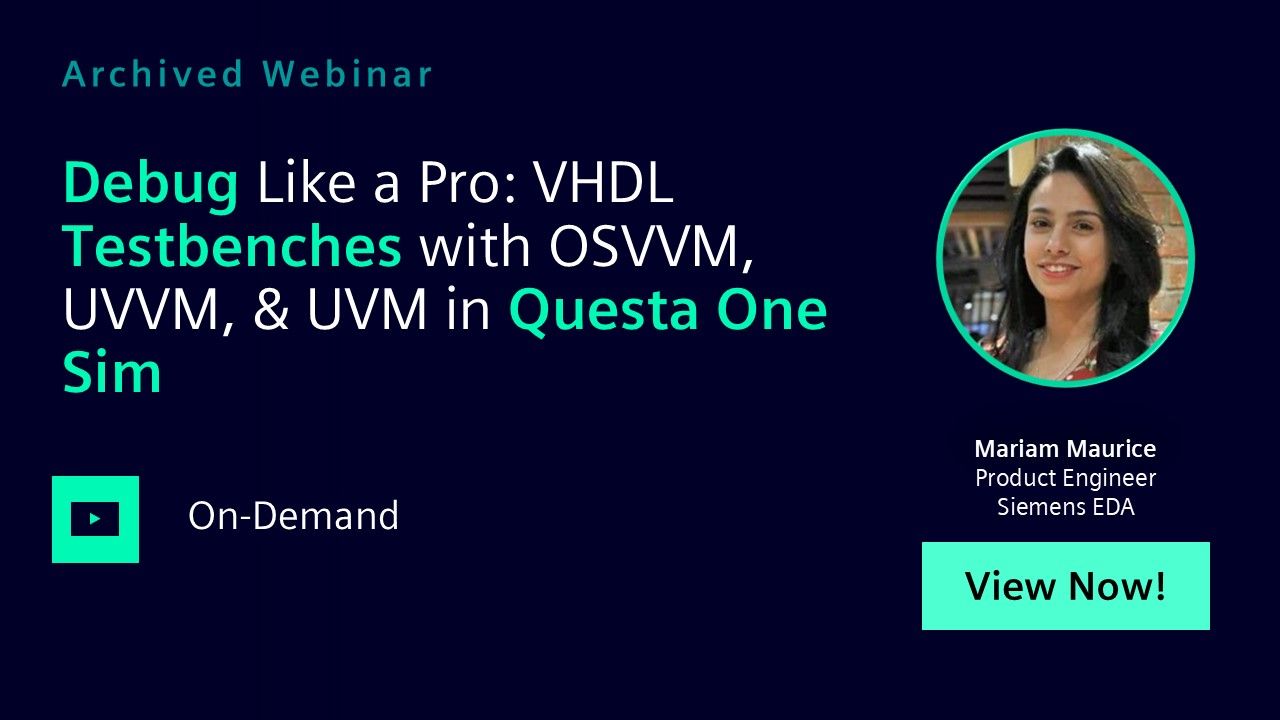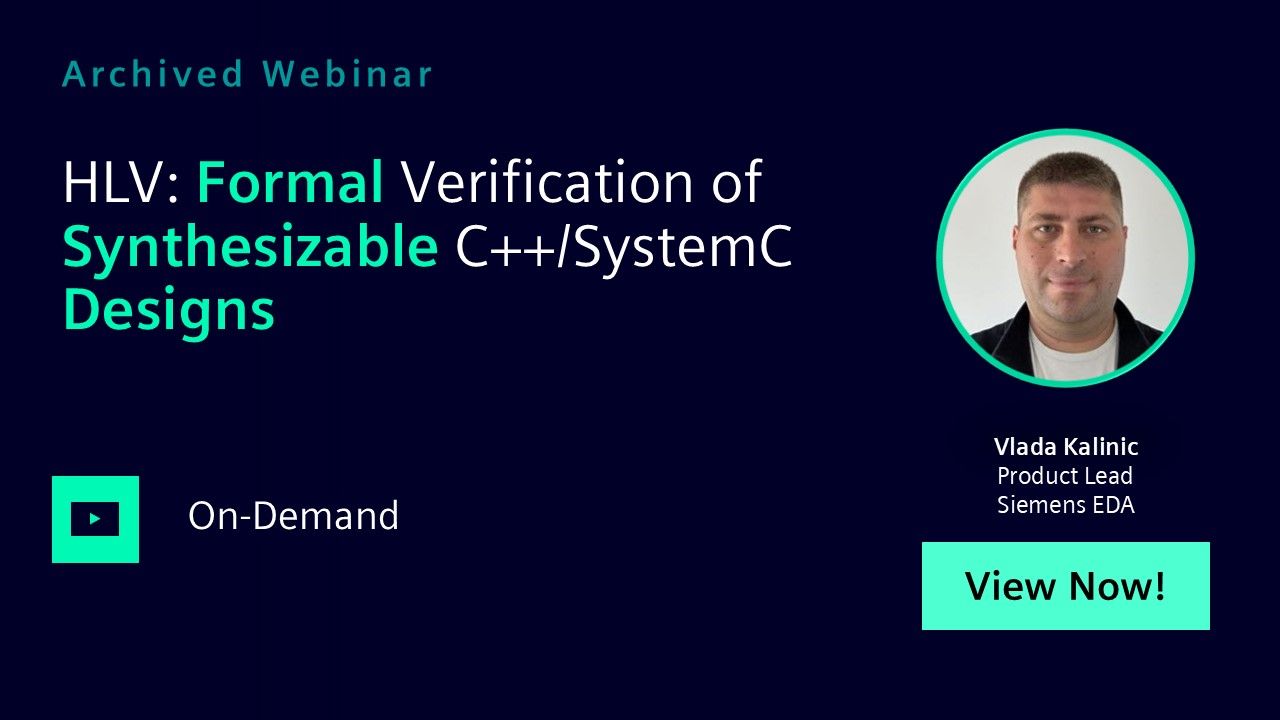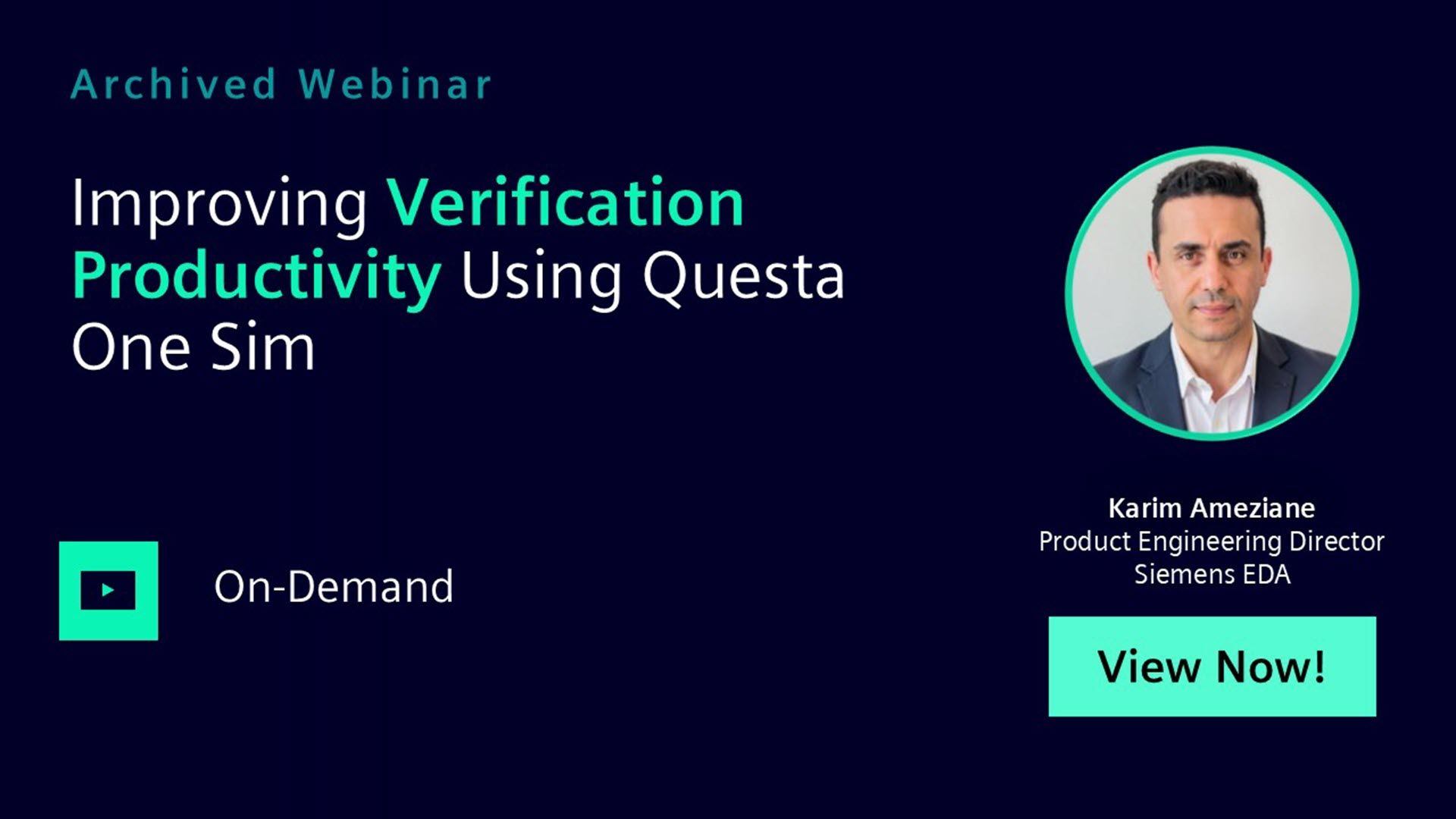Search Results
Filters
Advanced Search
2159 Results
-

Aerospace & Defense
Reference - Dec 03, 2025 by Todd Holbrook
Welcome to the Aerospace and Defense event archive, where you will find presentations and slide decks from live events that you may have missed. *Please note: you will need a valid login to download the session presentations.
-
Questa One Smart Verification: Unleashing the Potential of AI Within Functional Verification
Resource (Slides (.PDF)) - Dec 03, 2025 by Austin Mam
Leverage the power of AI and ML Smart Verification revolutionizes functional verification by using faster engines that complement traditional heuristics with machine learning. Allow engineers to be more productive with advanced creation, analysis, and debugging capabilities, while reducing workloads through predictive technologies that streamline and accelerate the verification process.
-
Ensure High Quality RTL with Early Continuous Integration
Resource (Slides (.PDF)) - Dec 03, 2025 by Walter Gude
Learn the value of Continuous Integration (CI) during development and how Questa Design Solutions are ideally suited for implementation in CI flows. Discover the benefits of integrating CI early to enhance RTL quality and streamline development processes.
-
Enhancing Verification Productivity with Questa One
Resource (Slides (.PDF)) - Dec 03, 2025 by Sunil Sahoo
Improving productivity has become crucial for efficiently utilizing expensive human and grid resources in the functional verification process. Achieving the "done" state requires more than simulator performance— it demands a strategic focus on optimizing workflows, prioritizing tasks, and leveraging metrics to guide efforts. Questa One Sim's productivity-driven approach ensures resources are deployed effectively, accelerating verification closure.
-
VA Live - Scottsdale: Introduction and Welcome
Resource (Slides (.PDF)) - Dec 03, 2025 by Todd Holbrook
Welcome to Verification Academy Live.
-

Verification Academy Live: Scottsdale
Seminar - Dec 03, 2025 by Joe Hupcey
This seminar will update you on technologies and techniques to increase your verification productivity today. How the new AI/ML paradigm shift across the industry is enabling functional verification productivity gains The benefits of an automated Continuous Integration flow to enhance RTL quality and streamline development processes The latest advancements in the RTL simulation Wednesday, December 3, 2025 | 9:30 AM - 5:00 PM Location TopGolf 9500 E. Talking Stick Way Scottsdale, AZ 85256
-

Debug Like a Pro: VHDL Testbenches with OSVVM, UVVM, & UVM in Questa One Sim
Webinar - Dec 03, 2025 by Mariam Maurice
This webinar explores the debugging capabilities and best practices across the three leading VHDL verification (OSVVM, UVVM, UVM) frameworks.
-
Debug Like a Pro: VHDL Testbenches with OSVVM, UVVM, & UVM in Questa One Sim
Resource (Slides (.PDF)) - Dec 03, 2025 by Mariam Maurice
This webinar explores the debugging capabilities and best practices across these three leading VHDL verification frameworks.
-
Questa One Avery Verification IP: Delivering Accelerated Confidence
Resource (Slides (.PDF)) - Nov 19, 2025 by Luis Rodriguez
In this session, you will learn how Questa One Avery VIP’s cutting-edge technologies promise to enhance productivity and ease of use in the rapidly expanding landscape of complex interfaces and memory protocols, spanning SoC designs, 3DIC chiplets, and FW/SW integration.
-
Enhancing Verification Productivity with Questa One Sim
Resource (Slides (.PDF)) - Nov 19, 2025 by Sunil Sahoo
In this session, you will learn how Questa One Sim’s productivity-driven approach ensures resources are deployed effectively, accelerating verification closure.
-

MARLUG - 2025
Seminar - Nov 19, 2025 by Sunil Sahoo
User2User Mid-Atlantic is your opportunity to learn, grow and connect with fellow technical experts who design leading-edge electronics products using Siemens EDA tools.
-
System Testbench with Questa Parallelsim
Resource (Slides (.PDF)) - Nov 19, 2025 by John Liu - Northrop Grumman
In this session, you will learn how Questa ParallelSim processing significantly improves test efficiency and performance in a complex multichip FPGA system.
-

Don't Let VHDL Debugging Slow You Down! Use Questa One Sim
Webinar - Nov 12, 2025 by Nicole Munson
In this webinar, you will learn how Questa One Sim empowers VHDL designers to dramatically enhance their debugging productivity. We'll move beyond basic simulation viewing and dive into advanced features designed to pinpoint issues faster, understand design behavior more intuitively, and streamline your entire VHDL RTL debug workflow.
-
Don't Let VHDL Debugging Slow You Down! Use Questa One Sim
Resource (Slides (.PDF)) - Nov 12, 2025 by Nicole Munson
In this webinar, you will learn how Questa One Sim empowers VHDL designers to dramatically enhance their debugging productivity.
-
Introducing BUGGED OUT — A new bite-sized podcast for verification engineers
Resource (Verification Horizons Blog) - Nov 10, 2025 by Harry Foster
I’m excited to share something I’ve been working on for a while — my new podcast, BUGGED OUT . If you’ve been in verification long enough, you know the truth: Every chip has bugs. The real challenge — and the real creativity — is in how we find and fix them quickly. This podcast is about that work. Each episode is 10–15 minutes, designed for a commute, a coffee break, or that moment when your simulation farm is spinning and you finally have a minute to think.
-

BUGGED OUT Podcast
Podcast - Nov 10, 2025 by Harry Foster
Every chip has bugs — the real question is how fast you can find and fix them. BUGGED OUT is the bite-sized podcast where we shine a light on the art (and science) of functional verification.
-

HLV: Formal Verification of Synthesizable C++/SystemC Designs
Webinar - Nov 05, 2025 by Vlada Kalinic
Formal check tools are difficult to be analyzed on generated RTL (as the errors cannot be correlated to HLS source code) Catapult Formal/Onespin SystemC help to overcome this challenge. Under HLV there are several apps, to verify and clean C++ HLS code before running HL Synthesis and then apply equivalency between C++ and RTL to guarantee that golden C++ is equivalent with final RTL design.
-
HLV: Formal Verification of Synthesizable C++/SystemC Designs
Resource (Slides (.PDF)) - Nov 05, 2025 by Vlada Kalinic
Under HLV there are several apps, to verify and clean C++ HLS code before running HL Synthesis and then apply equivalency between C++ and RTL to guarantee that golden C++ is equivalent with final RTL design.
-
Improving Verification Productivity Using Questa One Sim
Resource (Slides (.PDF)) - Oct 23, 2025 by Karim Ameziane
This webinar is essential for verification engineers and managers looking to overcome the challenges of increasing design complexity and achieve superior verification efficiency and faster time-to-market with Siemens' Questa One Sim.
-

Improving Verification Productivity Using Questa One Sim
Webinar - Oct 23, 2025 by Karim Ameziane
This webinar is essential for verification engineers and managers looking to overcome the challenges of increasing design complexity and achieve superior verification efficiency and faster time-to-market with Siemens' Questa One Sim. Furthermore, the webinar will showcase Questa One Sim's cutting-edge debugging tools. Experience how advanced capabilities like Protocol Debug, and X-Debug enhance productivity, enabling you to find bugs faster.
-
New RTL Modeling Constructs in Verilog
Resource (Verification Horizons Blog) - Oct 16, 2025 by Dave Rich
I’ve been packing up my office as Siemens is closing my location. This marks the longest I’ve ever spent in a single office, a whopping 15 years. Coincidentally, I was in the same building earlier with another company, Avant! for an additional 2 years. I’ve got a box of stuff from previous jobs that I rarely unpack. But it happened to go through it and found the proceedings from what was to become the first DVCon in 1992. I doubt these proceedings exist anywhere in digital form.
-
Combining Performance and Formal Security Guarantees for Hardware Accelerators
Resource (Slides (.PDF)) - Oct 16, 2025 by Lucas Deutschmann - RPTU University Kaiserslautern-Landau
-
Ground Truth in the Age of AI: Abstract Models as the Anchor of Verification
Resource (Slides (.PDF)) - Oct 16, 2025 by Tobias Ludwig - Lubis EDA
-
Adaptable FWHW Formal Co-Verification of SoC RISC-V Components
Resource (Slides (.PDF)) - Oct 16, 2025 by Bryan Olmos - Infineon
The increasing shift towards the RISC-V open-source instruction set architecture requires the development of new design techniques. In recent years, it has been demonstrated that RISC-V designs can be generated in a modular and scalable manner by utilizing metamodeling techniques.
-
Formally Verifying Security Properties of CHERI Hardware and Software
Resource (Slides (.PDF)) - Oct 16, 2025 by Thomas Bauereiss - University of Cambridge